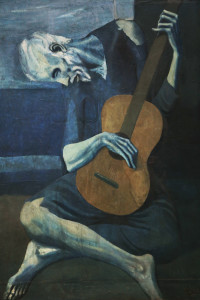The genesis of Spanish master Pablo Picasso’s (1881-1973) aptly named “Blue Period” was the

suicide of a dear friend and fellow artist Carlos Casagemas (1880-1901). At the time, Picasso’s paramour was the object of Casagemas’ desire. After discovering their affair, Casagemas attempted to shoot her. When he failed, he shot himself. Picasso was so wracked with guilt he focused his paintings on the melancholy surrounding his own poverty—often painting outsiders as subjects. Painted in late 1903 through early 1904, “The Old Guitarist” is perhaps the most iconic work of The Blue Period. The work recalls earlier Mannerist paintings, with its elongated proportions (mirroring the work of El Greco) and monochromatic color scheme which flattens the figure into two-dimensions. The oil on panel currently hangs in the Art Institute of Chicago, where the museum claims it was the first Picasso painting ever to enter a museum’s permanent collection.

Following Post-Impressionism, Expressionism paved the way for Picasso’s more evocative works. Even in the nascence of his career, Picasso deviated from imitating nature in favor of examining figures and recombining them in inventive ways. X-ray reveal no less than three different figures lingering beneath the paint of “The Old Guitarist”, as art supplies were in short supply for the young, struggling artist. “The Old Guitarist” could be blind—aligning the painting with other Blue Period works such as “Celestina” where subjects with altered sight suggest vision beyond this world. The guitar and peculiar geometry of the bent figure are the only deviations from dominant, yet dingy, blues. The centrality of the guitar suggests the artist is dependent upon the guitar for his livelihood.
As such, “The Old Guitarist” itself is a microcosm of Picasso’s life at the time— The artist, too blind for this world, must live a solitary life; yet also depend on society to survive. The Old Guitarist (1903-1904)
” Pablo Picasso’s Old Guitarist ” copyright Robin Rile Fine Art



